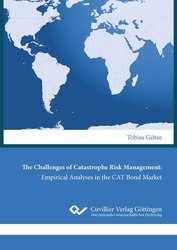| Departments | |
|---|---|
| Book Series (96) |
1378
|
| Nachhaltigkeit |
3
|
| Gesundheitswesen |
1
|
| Humanities |
2364
|
| Medienwissenschaften | 16 |
| Theology | 57 |
| Philosophy | 102 |
| Law | 422 |
| Economics | 850 |
| Social sciences | 416 |
| Sports science | 48 |
| Psychology | 233 |
| Educational science | 190 |
| History | 182 |
| Art | 111 |
| Cultural studies | 166 |
| Literary studies | 116 |
| Linguistics | 88 |
| Natural Sciences |
5406
|
| Engineering |
1793
|
| Common |
98
|
|
Leitlinien Unfallchirurgie
5. Auflage bestellen |
|
Advanced Search
The Challenges of Catastrophe Risk Management: Empirical Analyses in the CAT Bond Market (English shop)
Tobias Götze (Author)Preview
Extract, PDF (480 KB)
Table of Contents, PDF (32 KB)
Due to the increasing relevance of natural catastrophes as a significant global source of risk and the capacity constraints in primary insurance and reinsurance markets, CAT bonds have become an important instrument to manage catastrophe risks by transferring them to the capital market. In three empirical studies, this dissertation examines the challenges related to catastrophe risk management with CAT bonds. First, the factors that influence the substitution of traditional reinsurance by CAT bonds are identified. These factors consist of the insured risk layer and the extends of reinsurer default risk, basis risk, and asymmetric information. Second, the accessibility of the CAT bond market for (re)insurance companies is analyzed and the results exhibit the existence of barriers to market entry in the form of higher premiums being paid by less reputable and financially weaker CAT bond sponsors. The third empirical study shows that CAT bond sponsors are susceptible to moral hazard, but also that moral hazard can be successfully prevented by sufficient loss retention or by the use of non-indemnity CAT bonds. Altogether, this dissertation contributes to improving the understanding of the CAT bond market and the challenges of catastrophe risk management using CAT bonds.
| ISBN-13 (Hard Copy) | 9783736973787 |
| ISBN-13 (eBook) | 9783736963788 |
| Final Book Format | A5 |
| Language | English |
| Page Number | 194 |
| Lamination of Cover | glossy |
| Edition | 1 |
| Publication Place | Göttingen |
| Place of Dissertation | Braunschweig |
| Publication Date | 2021-02-22 |
| General Categorization | Dissertation |
| Departments |
Economics
Statistics and operations research, business mathematics Insurance industry |
| Keywords | Added Value, Asymmetric Information, Alternative Risk Transfer, Capacity, Capital Market, CAT Bond, Catastrophic Risk, Climate Change, Demand, Disaster, Diversification, Earthquake, Efficiency, Empirical Evidence, Entry Barrier, Extreme Weather Events, Hurricane, Indemnity Trigger, Information Inefficiencies, Insurance, Insurance-Linked Securities, Katrina, Loss, Market Access, Mitigation, Moral Hazard, Natural Catastrophe, Pricing Model, Protection Gap, Reinsurance, Retention, Risk Management, Risk Management Theory, Risk Premium, Risk Transfer, Sponsor, Substitution Effect, Supply, Tohoku, Trigger Mechanism, Alternativer Risikotransfer, Angebot, Begrenzung, Desaster, Diversifikation, Effizienz, Eintrittsbarriere, Empirische Evidenz, Entschädigungstrigger, Erdbeben, extreme Wetterereignisse, Hurrikan, Informationsasymmetrie, Informationsineffizienz, Kapazität, Kapitalmarkt, Katastrophenanleihe, Katastrophenrisiko, Katrina, Klimawandel, Marktzugang, Mehrwert, Moral Hazard, Nachfrage, Naturkatastrophe, Preismodel, Protection Gap, Retention, Risikoprämie, Risikomanagement, Risikomanagementtheorie, Risikotransfer, Rückversicherung, Schaden, Sponsor, Substitutionseffekt, Tohoku, Triggermechanismus, Versicherung, Fassungsvermögen, Risikostreuung, Preisgestaltung, Kalkulation, costing, Anleihen, bonds, claims settlement, claims settlement |








